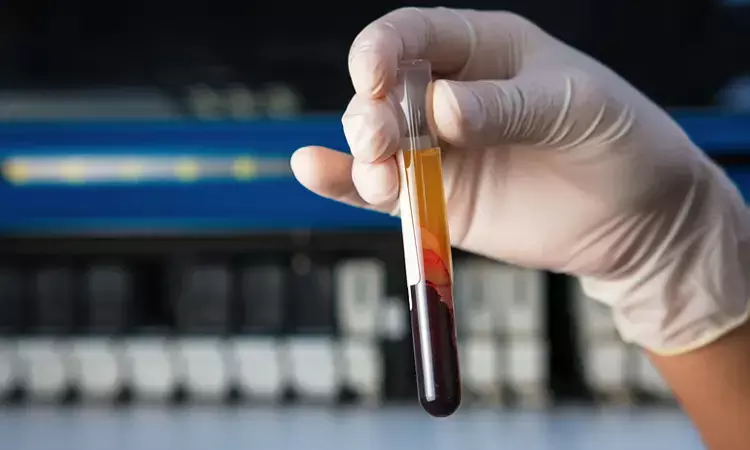- Home
- Medical news & Guidelines
- Anesthesiology
- Cardiology and CTVS
- Critical Care
- Dentistry
- Dermatology
- Diabetes and Endocrinology
- ENT
- Gastroenterology
- Medicine
- Nephrology
- Neurology
- Obstretics-Gynaecology
- Oncology
- Ophthalmology
- Orthopaedics
- Pediatrics-Neonatology
- Psychiatry
- Pulmonology
- Radiology
- Surgery
- Urology
- Laboratory Medicine
- Diet
- Nursing
- Paramedical
- Physiotherapy
- Health news
- Fact Check
- Bone Health Fact Check
- Brain Health Fact Check
- Cancer Related Fact Check
- Child Care Fact Check
- Dental and oral health fact check
- Diabetes and metabolic health fact check
- Diet and Nutrition Fact Check
- Eye and ENT Care Fact Check
- Fitness fact check
- Gut health fact check
- Heart health fact check
- Kidney health fact check
- Medical education fact check
- Men's health fact check
- Respiratory fact check
- Skin and hair care fact check
- Vaccine and Immunization fact check
- Women's health fact check
- AYUSH
- State News
- Andaman and Nicobar Islands
- Andhra Pradesh
- Arunachal Pradesh
- Assam
- Bihar
- Chandigarh
- Chattisgarh
- Dadra and Nagar Haveli
- Daman and Diu
- Delhi
- Goa
- Gujarat
- Haryana
- Himachal Pradesh
- Jammu & Kashmir
- Jharkhand
- Karnataka
- Kerala
- Ladakh
- Lakshadweep
- Madhya Pradesh
- Maharashtra
- Manipur
- Meghalaya
- Mizoram
- Nagaland
- Odisha
- Puducherry
- Punjab
- Rajasthan
- Sikkim
- Tamil Nadu
- Telangana
- Tripura
- Uttar Pradesh
- Uttrakhand
- West Bengal
- Medical Education
- Industry
Lipid screening in Adolescence fails to Improve Cardiovascular Risk Prediction, reveals research

Researchers have found that the risk factors for cardiovascular events in adulthood can be predicted by non laboratory-based adolescent risk factors alone. This conclusion came from a study based in the United States, Australia, and Finland. The study was published in the journal Pediatrics conducted by Nuotio and colleagues.
Data analysis was carried out on all 11,550 participants: who had their risk factors assessed during their adolescent periods with non laboratory factors being among them including, body mass index, blood pressure and smoking status while lipid factors included among others, total cholesterol, and triglycerides. Participants were then followed into adulthood; cardiovascular events, including fatal and nonfatal events, were monitored after age 25. All events were medically adjudicated to ensure proper diagnosis.
The primary aim was to find whether the introduction of lipid measurements (total cholesterol and triglycerides) increased the predictability of the occurrence of future cardiovascular events by nonlaboratory factors which include age, sex, blood pressure, BMI, and smoking. Hazard ratios for all these risk factors were estimated based on multivariable Cox regression models and the discrimination ability of every model was assessed through the use of C-statistics.
• Of the 11,550 participants, 513 people (4.4%) had a confirmed cardiovascular event during adulthood.
• Non-laboratory-based risk factors that included high blood pressure (hazard ratio [HR] 1.25; 95% confidence interval [CI], 1.03–1.52), being overweight (HR 1.76; 95% CI, 1.42–2.18), obese (HR 2.19; 95% CI, 1.62–2.98), smoking (HR 1.63; 95% CI, 1.37–1.95), and high total cholesterol (HR 1.79; 95% CI, 1.39–2.31) had all emerged as significant predictors of cardiovascular events (P < .05).
• Adding lipid measures (total cholesterol and triglycerides) to the non laboratory-based model was not associated with a significant improvement in the ability to predict cardiovascular events. The C-statistic for the model including lipids was 0.75 (SD 0.07), the same as for the non laboratory model without lipids 0.75 [SD 0.07]; P = .82). That is, adding lipid measurements did not improve discriminatory power.
This study reports that adolescent non laboratory-based risk factors, such as blood pressure, BMI, and smoking, independently predict cardiovascular events in adulthood. The addition of lipid measurements, including total cholesterol and triglycerides, failed to improve the accuracy of predictions. These data suggest what is required is inclusion of non laboratory-based risk models for predicting long-term cardiovascular risk, and routine lipid testing may be less than clearly indicated for cardiovascular risk assessment in adolescence.
Reference:
Nuotio, J., Laitinen, T. T., Magnussen, C. G., Sinaiko, A. R., Bazzano, L. A., Daniels, S. R., Jacobs, D. R., Jr, Kartiosuo, N., Koskinen, J., Burgner, D. P., Kähönen, M., Raitakari, O. T., Steinberger, J., Urbina, E. M., Venn, A. J., Viikari, J. S. A., Woo, J. G., Dwyer, T., & Juonala, M. (2024). Predictors in youth of adult cardiovascular events. Pediatrics. https://doi.org/10.1542/peds.2024-066736
Dr Riya Dave has completed dentistry from Gujarat University in 2022. She is a dentist and accomplished medical and scientific writer known for her commitment to bridging the gap between clinical expertise and accessible healthcare information. She has been actively involved in writing blogs related to health and wellness.
Dr Kamal Kant Kohli-MBBS, DTCD- a chest specialist with more than 30 years of practice and a flair for writing clinical articles, Dr Kamal Kant Kohli joined Medical Dialogues as a Chief Editor of Medical News. Besides writing articles, as an editor, he proofreads and verifies all the medical content published on Medical Dialogues including those coming from journals, studies,medical conferences,guidelines etc. Email: drkohli@medicaldialogues.in. Contact no. 011-43720751


